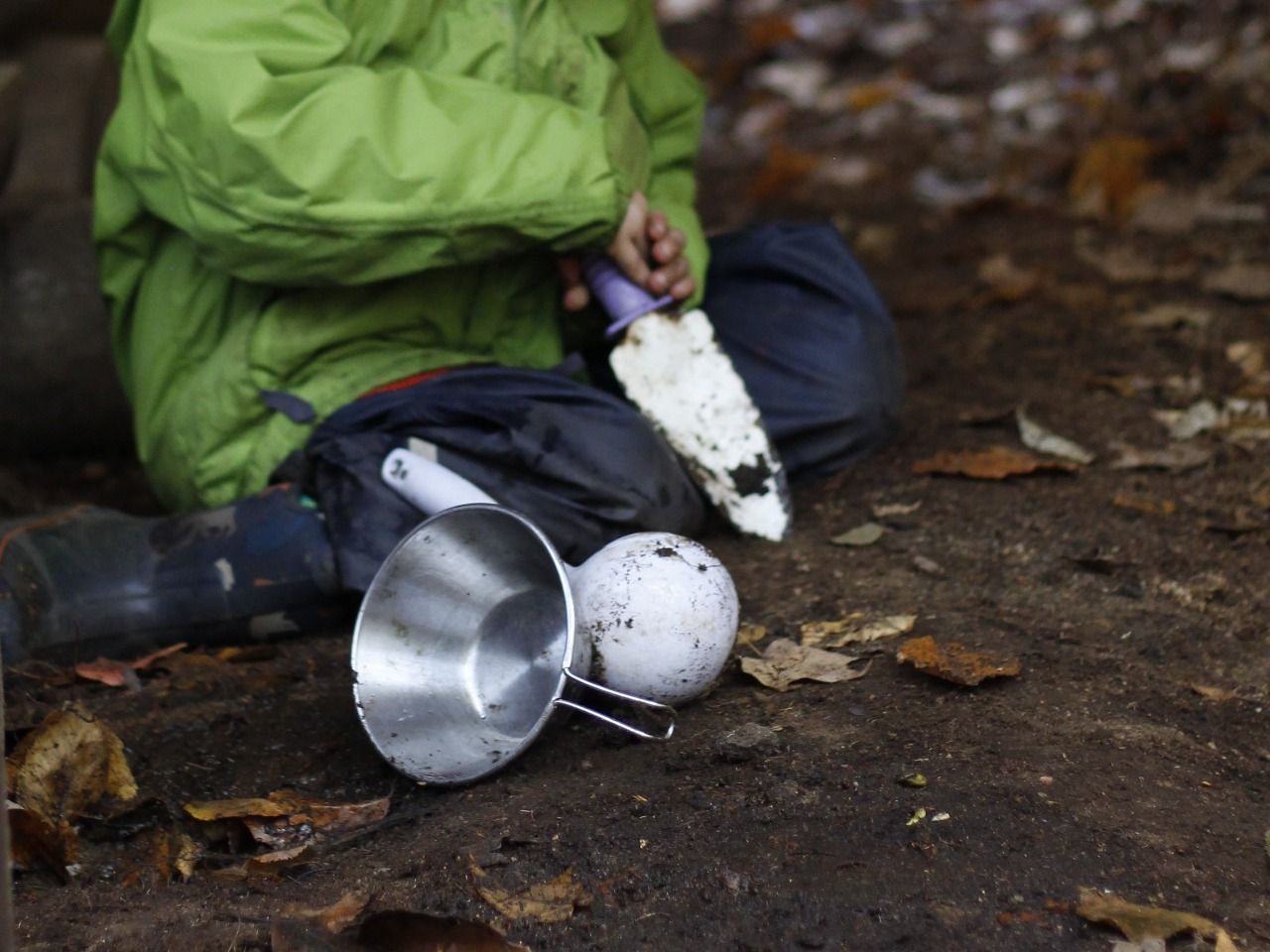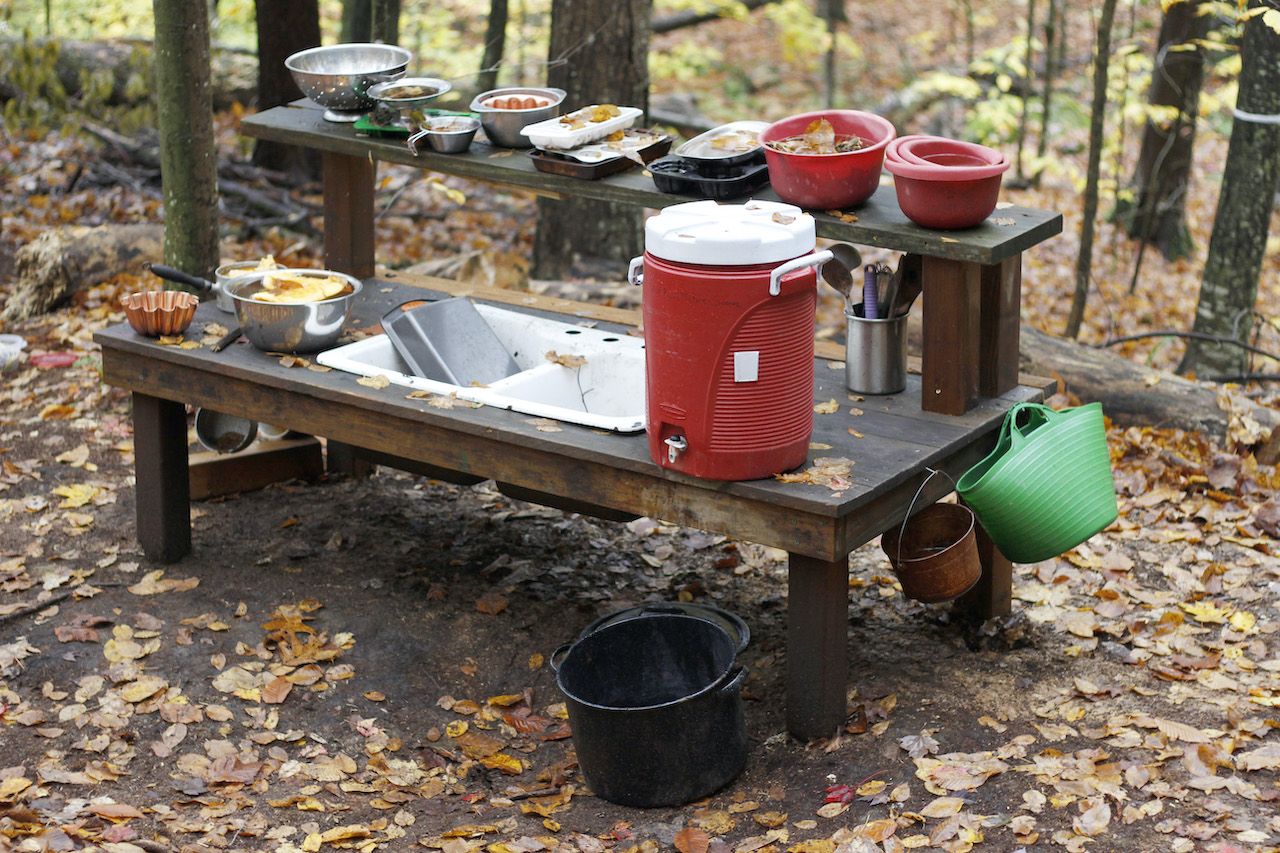
Blog
Stories from my personal journey learning about and delivering Nature-rooted programs across three different countries
Guest Blog: Environmental Education (and Magic!) in the Mud Kitchen at Forest Days
Landere Naisbitt

Empty space, drag to resize
Written by Landere Naisbitt, Outreach Coordinator for the Blue Hill Heritage Trust
Empty space, drag to resize
What is a mud kitchen, you might ask? It might sound dirty (which it is); it might sound like silly nonsense (which it is not); it might sound like blissful fun (which it can be) and it might sound a note of magic as well – after all, many potions are created in this special place in the forest!
Mud kitchens are play spaces, very simple ones, where a few pots, pans, and other unbreakable cooking ware are scattered under the trees, or stacked in a muddy corner. Some mud kitchens are fancier and built by adults for children, but often they are nothing more than a few inexpensive pots from a thrift store and whatever you can find on the forest floor (keeping in mind impacts on other species and mentoring children to interact sustainably with their places).
Mud kitchens are richlearning spaces where children lean back into our old ways – foraging, gathering, making, sharing, and celebrating with each other and the forest – and sometimes by themselves.
There is creativity that comes out of the mud kitchen: music, ice sculptures, natural dye, ornately decorated cakes. There is ample imagination in the games children make up, in the stories they imagine they are apart of, in the dishes they are “cooking.”
At the end of our Forest Days we often say a chant that goes like this: “The forest is deep and the forest is wide, the forest has lots of things inside. It has…” and the children offer suggestions of what they have experienced that day. One time a kindergarten boy piped up and said, “…it has imagination!”
There are interactions with earth elements in many forms: water from the river in liquid form, as ice, and slush; dirt that is dry, that is mud, that is frozen and uplifted from the ground by ice crystals.
So many sensory experiences happen in the mud kitchen from feeling the textures of lichen, the squish of mud, to listening to the crunch of fall leaves, playing music with a pot and stick, smelling pine needles, tasting wintergreen, lifting mud cakes, and delicately placing winter berry on top of chocolate (mud) cupcakes.

There is foraging, of course, which means plant identification, remembering the honorable harvest, and getting to know a place so well that you know exactly where to go in search of Canada mayflower berries when you need them. There is often controversy about what children should be able to touch and not touch in natural settings. I like the following statement about this from Natural Curiosity:
“When bringing children into natural settings, we need to find a way to promote respectful behaviour towards plants and animals without losing sight of children’s driving need for active interaction with their world. While there is a range of opinion among environmentalists, thinkers such as David Sobel (2008) and Robert Pyle (2002) stress the need for children to touch as well as look, to pick things up and use them in many ways, to climb trees, wander off the trail, build forts, catch frogs, or insects, collect specimens. Citing a strong link between childhood foraging (collecting objects for some use whether aesthetic, magical, or practical) and children’s knowledge of biodiversity, Sobel makes an argument for encouraging “hunting and gathering” rather than discouraging it in the interests of environmental sanctity. When children are allowed to build relationships in places where nature is robust enough to withstand their incursions, they can be extraordinarily careful and restrained in more environmentally sensitive areas. In the end a look don’t touch attitude to the natural world only reinforces the idea that we are separate from nature rather than apart of it” (Anderson, et al, 2014).
Often social-emotional learning emerges from the mud kitchen experience as well as children figure out how to share pots and pans, take turns pouring water, help each other with the task of baking a cake in the forest. It is not always easy as there are never enough pots to go around! Valuable lessons are learned under the patient spruce trees.
Taking care of the forest also happens in the mud kitchen, believe it or not. One cold November day a child found a worm in the mud. Not only was this wildlife sighting extremely exciting, but it started a conversation of what do worms do in the winter time? Soon the children were concerned for the worm and made it a hibernaculum under the mud and under a favorite heart-shaped pan. When we left the forest that day I was given strict instructions not to remove the pan as it was protecting their worm friend for the winter!
Another example of caring for the forest was a gesture made by a kindergartner to the little spruce tree in the clearing. We spent some time one day giving gifts to the forest close to the holiday season and this particular child made stars of snow in the mud kitchen and brought them to lean up against the base of the little tree.
Sometimes celebrations spring from the mud kitchen as well. One time a chocolate birthday cake was made for a classmate and another time refreshments were served in a new fort that had just been built. Sometimes a tray of mud and moss cupcakes are left in the middle of our closing circle for everyone to enjoy at the end of our time in the forest.

Sometimes I wonder if the mud kitchen isn’t a form of therapy. Some children will plop down in the mud kitchen area to make mud cakes and pour water the entire session, not leaving once until the gathering up call is sounded, and we have to return to school. What are they washing away and sorting out in their own spirits? What dreams are they cooking up for their future and the future of the earth? What is this experience satisfying in them? I know that for myself sometimes just focusing in on a little piece of the world is comforting and manageable and for some, the feeling of mud between the fingers, is quite calming. A local school guidance counselor said about Forest Days and nature connection in general: it’s definitely a piece we are missing in our system.”
Lastly, it seems like the mud kitchen can provide a sort of home in the forest for those needing this comfort. In the fall, when the pine needles are warm on the earth and their pungent smell wafts up through the gently swaying evergreen branches, where else would any of us like to be then in that patch of sunlight on the forest floor, stirring natural things in an old pot, listening to the birds, and day-dreaming?
In the mud kitchen there is no structure, there are no lesson plans, but as you can see from all the above so much embodied learning and growing is happening there all the time.
Essentially, what I just described is play but isn’t it learning too? I think the mud kitchen is a great example of how play equals learning, how play equals building relationships, and how play equals satisfying basic human needs.
Something more than intellectual learning is happening out there in the forest – it is embodied learning and a little bit of magic too. A volunteer for our program said after her first visit, “It is magical out there!” and has continued to return to enjoy the time as much as the children!

I can wax lyrical about play and its benefits forever through my own anecdotal stories. However, research is starting to show (what we have known for ages now) that play is essential for healthy development.
“Play is so important to optimal child development that it has been recognized by the United Nations High Commission for Human Rights as a right of every child. Play allows children to use their creativity while developing their imagination, dexterity, and physical, cognitive, and emotional strength. Play is important to healthy brain development. Play helps children develop new competencies that lead to enhanced confidence and the resiliency they will need to face future challenges. Undirected play allows children to learn how to work in groups, to share, to negotiate, to resolve conflicts, and to learn self-advocacy skills. When play is allowed to be child driven, children practice decision-making skills, move at their own pace, discover their own areas of interest, and ultimately engage fully in the passions they wish to pursue” (Ginsberg, 2007 )
Outdoor Play Canada shared a Facebook post on Nov 20th, 2019 which was the 30th anniversary of the United Nations Convention on the Rights of the Child and shared this:
“Access to active play in nature and outdoors—with its risks—is essential for healthy child development. We recommend increasing children’s opportunities for self-directed play outdoors in all settings—at home, at school, in child care, the community and nature…There are also unique benefits of being in the outdoors, particularly in nature. When children play the way they want outdoors they move more, sit less, and play longer. They get their hands dirty and are exposed to microbes that help them build immunity. They make their own goals and figure out the steps to attain those goals. They learn, build resilience, develop social skills, and learn how to manage risks and keep safe. Their eyes get the exercise needed to combat short-sightedness (Barnes, 2019).

Empty space, drag to resize
Empty space, drag to resize
About the Author:
Landere has spent the past 10 years working in the field of outdoor education in various capacities. She is currently employed by Blue Hill Heritage Trust as their Outreach Coordinator.

More Posts
WANT TO GET FOREST SCHOOLED TOO?
Subscribe to my email letters, something special from me to you so we can learn together. Each one is filled with heart-felt stories from the forest, resources you may find useful, and things that hopefully bring a smile too.
Thank you!
© by FOREST SCHOOLED
